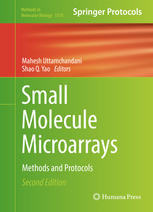

Most ebook files are in PDF format, so you can easily read them using various software such as Foxit Reader or directly on the Google Chrome browser.
Some ebook files are released by publishers in other formats such as .awz, .mobi, .epub, .fb2, etc. You may need to install specific software to read these formats on mobile/PC, such as Calibre.
Please read the tutorial at this link: https://ebookbell.com/faq
We offer FREE conversion to the popular formats you request; however, this may take some time. Therefore, right after payment, please email us, and we will try to provide the service as quickly as possible.
For some exceptional file formats or broken links (if any), please refrain from opening any disputes. Instead, email us first, and we will try to assist within a maximum of 6 hours.
EbookBell Team

4.0
76 reviewsSmall molecule microarrays (SMM) were introduced in 1999 and within just a short span of time, have established themselves as a vibrant next generation platform for high-throughput screening. Small Molecule Microarrays: Methods and Protocols consolidates a significant collection of examples, which serve to guide researchers toward ways in which SMM technology may be effectively deployed for multiplexed screening, drug discovery and ligand identification. The volume is organized into three sections covering microarray fabrication, imaging modes, and discovery approaches. The chapters cover a range of small molecule library types, ranging from synthetic combinatorial libraries to peptide and carbohydrate libraries, with lessons and techniques that can be widely applied. Written in the highly successful Methods in Molecular Biology series, format, chapters include introductions of their respective topics, lists of the requisite materials and reagents, step-by-step and readily reproducible laboratory protocols as well as vital tips on troubleshooting and advice on avoiding known pitfalls.
Authoritative and cutting-edge, Small Molecule Microarrays: Methods and Protocols provides meticulous insights into the successful applications of SMM, by experts in the field. Building on this collection of knowledge, the volume seeks to inspire a future generation of microarray practitioners to propel this significant technology to even greater heights